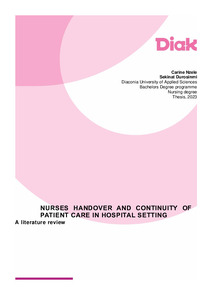Nurses handover and continuity of patient care in hospital settings.
Nzele, Carine; Sekinat, Durosinmi (2023)
Nzele, Carine
Sekinat, Durosinmi
2023
Julkaisun pysyvä osoite on
https://urn.fi/URN:NBN:fi:amk-2023060722727
https://urn.fi/URN:NBN:fi:amk-2023060722727
Tiivistelmä
Nurses all over the world begin and end their workday with a nurse’s handover. Nurses’ handover is a vital tool which is often prone to errors such as inaccurate information transfer, poor documentation and miscommunication which could lead to poor continuity of care and thereby pose risk to patient safety.
The purpose of this study was to explore factors that can influence nurses’ handover and its impact on the continuity of patient care and patient safety in hospital settings. The objective of this study is to investigate the different forms and handover tools used by nurses during handover in the hospital settings and to understand barriers and challenges to an effective handover and how it can affect the continuity of care. The aim is also to focus on the importance of handover in nursing and how to improve the handover process.
The research method used for this study was a literature review. Data for the research was collected from CINAHL, Science direct and ProQuest health research premium collection. Selection of articles was based on a predetermined inclusion and exclusion criteria. Selected articles were analysed and synthesized by thematic analysis.
Full texts of selected articles were thoroughly examined, and data obtained were categorized to create themes and subthemes. The study results identified four main themes after the data analysis of the selected articles: institutional system and guidelines, quality of handover, barriers to handover process, and patient safety.
The findings indicated that the use of structured and standardized handover tools, handoff communications, with the exclusions of barriers and risk factors to patient safety are key factors for a successful handover.
It can be concluded that nurses’ handover has been demonstrated as an important component of client care and continuity of care in hospital settings.
The purpose of this study was to explore factors that can influence nurses’ handover and its impact on the continuity of patient care and patient safety in hospital settings. The objective of this study is to investigate the different forms and handover tools used by nurses during handover in the hospital settings and to understand barriers and challenges to an effective handover and how it can affect the continuity of care. The aim is also to focus on the importance of handover in nursing and how to improve the handover process.
The research method used for this study was a literature review. Data for the research was collected from CINAHL, Science direct and ProQuest health research premium collection. Selection of articles was based on a predetermined inclusion and exclusion criteria. Selected articles were analysed and synthesized by thematic analysis.
Full texts of selected articles were thoroughly examined, and data obtained were categorized to create themes and subthemes. The study results identified four main themes after the data analysis of the selected articles: institutional system and guidelines, quality of handover, barriers to handover process, and patient safety.
The findings indicated that the use of structured and standardized handover tools, handoff communications, with the exclusions of barriers and risk factors to patient safety are key factors for a successful handover.
It can be concluded that nurses’ handover has been demonstrated as an important component of client care and continuity of care in hospital settings.
